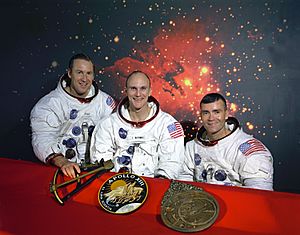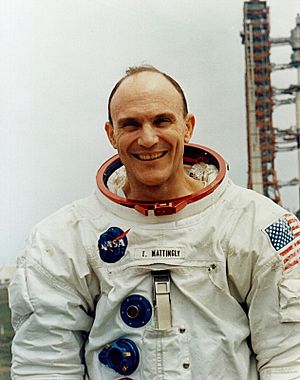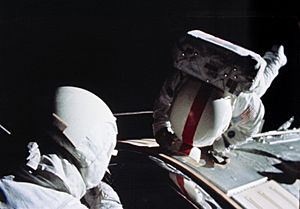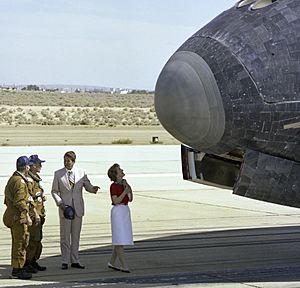Ken Mattingly facts for kids
Quick facts for kids
Ken Mattingly
|
|
|---|---|
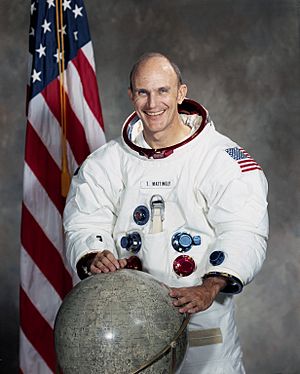
Mattingly in 1971
|
|
| Born |
Thomas Kenneth Mattingly II
March 17, 1936 Chicago, Illinois, U.S.
|
| Status | Retired |
| Died | October 31, 2023 (aged 87) Cincinnati, Ohio, U.S.
|
| Alma mater | Auburn University (BS, 1958) |
| Occupation | |
| Awards | NASA Distinguished Service Medal |
| Space career | |
| NASA Astronaut | |
| Rank | |
|
Time in space
|
21d 04h 34m |
| Selection | 1966 NASA Group 5 |
|
Total EVAs
|
1 |
|
Total EVA time
|
1 hour 23 minutes |
| Missions | Apollo 16, STS-4, STS-51-C |
|
Mission insignia
|
|
| Retirement | June 1985 |
Thomas Kenneth Mattingly II (March 17, 1936 – October 31, 2023) was an American pilot, aeronautical engineer, and test pilot. He became a rear admiral in the United States Navy and a NASA astronaut.
Mattingly flew on three important space missions: Apollo 16, STS-4, and STS-51-C. He is famous for being part of the Apollo 13 mission crew, but he was replaced just before launch. This happened because he might have been exposed to German measles.
Later, Mattingly flew as the Command Module Pilot for Apollo 16. He orbited the Moon 64 times. This made him one of only 24 people to ever fly to the Moon. During Apollo 16's trip back to Earth, Mattingly did a spacewalk. He went outside the spacecraft to get film from its exterior. This was a rare "deep space" spacewalk, far from any planet.
| Top - 0-9 A B C D E F G H I J K L M N O P Q R S T U V W X Y Z |
Early Life and Education
Thomas Kenneth Mattingly II was born on March 17, 1936. His birthplace was Chicago, Illinois. His parents were Thomas Kenneth Mattingly and Constance Mason Mattingly.
His father worked for Eastern Airlines. The family moved to Hialeah, Florida when Ken was very young. He often said his earliest memories were all about airplanes.
Mattingly was active in the Boy Scouts of America. He reached the rank of Life Scout. This is the second highest rank in Scouting. He finished Miami Edison High School in 1954. In 1958, he earned a Bachelor of Science degree. He studied Aeronautical Engineering at Auburn University.
Military Career
Mattingly joined the U.S. Navy in 1958. He became an Ensign. In 1960, he earned his pilot wings. He flew Skyraider propeller planes. He was part of Attack Squadron Thirty-five (VA-35). He flew from the aircraft carrier USS Saratoga.
Later, he flew Skywarrior jet planes. He was with Heavy Attack Squadron Eleven (VAH-11). He also flew from the USS Franklin D. Roosevelt.
Mattingly wanted to join the Navy's test pilot school. He ended up getting a spot at the U.S. Air Force Aerospace Research Pilot School. This was at Edwards Air Force Base in California. Other future astronauts were his classmates there. His instructors included Charles Duke, who would fly with him on Apollo 16.
Mattingly has flown for 7,200 hours in total. About 5,000 of those hours were in jet aircraft.
NASA Career
Becoming an Astronaut
In 1965, NASA started looking for new astronauts. They needed U.S. citizens born after 1929. They also had to be no taller than six feet. Pilots needed at least 1,000 hours flying jet aircraft.
Mattingly wasn't very interested in becoming an astronaut at first. But his mind changed at test pilot school. He and his classmates could apply to NASA. He was interviewed by astronauts John Young and Michael Collins.
Even though he thought he messed up the interview, Mattingly got a call. Deke Slayton, NASA's flight crew director, offered him a spot. Mattingly was selected as an astronaut in April 1966. He was a lieutenant in the Navy at the time.
Early Apollo Missions
Mattingly first worked as part of the support team for Apollo 8. He was a CAPCOM. This meant he talked to the astronauts from Earth. He helped them prepare to return home.
He also trained as a backup pilot for Apollo 11. This was the mission that first landed humans on the Moon. He was the backup Command Module Pilot.
The Apollo 13 Story
Mattingly was supposed to be the Command Module Pilot on Apollo 13. But three days before the launch, he was removed. This was because he might have been exposed to German measles. He never actually got sick. Jack Swigert took his place.
Because of this, Mattingly missed the dramatic in-flight explosion. The explosion badly damaged the spacecraft. However, Mattingly played a big role in helping the crew. He helped them figure out how to save power. This was very important for their safe return to Earth.
Apollo 16 Mission
After Apollo 13, Mattingly was assigned to Apollo 16. This was the fifth mission to land on the Moon. It launched on April 16, 1972. The crew included John Young (Commander) and Charlie Duke (Lunar Module Pilot). Mattingly was the Command Module Pilot.
Their mission was to collect rock samples. They explored the lunar highlands near the Descartes crater. While orbiting the Moon, they used instruments to map the Moon's surface. They also did 26 different science experiments.
On the way back to Earth, Mattingly did a spacewalk. This is called an extravehicular activity (EVA). He went outside the spacecraft to get film and data. These were stored in the science bay. Even though the mission ended a day early, they completed all their main goals.
Space Shuttle Flights
After his Apollo missions, Mattingly worked on the Space Shuttle program. He helped manage its development.
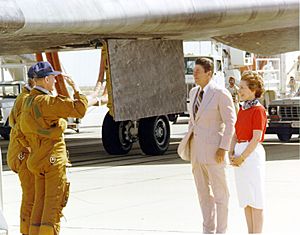
Mattingly commanded STS-4. This was the fourth and final test flight of the Space Shuttle Columbia. It launched on June 27, 1982. Henry W. Hartsfield Jr. was the pilot. This seven-day mission tested the shuttle's launch and landing. They also studied how extreme temperatures affected the shuttle.
The crew also did several science experiments. One experiment studied how to separate biological materials. They also fixed an issue to activate a "Getaway Special" experiment. This included studies on algae, fruit fly genetics, and more. STS-4 orbited Earth 112 times. It landed on July 4, 1982. President Ronald Reagan greeted Mattingly and Hartsfield.
Mattingly also commanded STS-51-C. This was the first Space Shuttle mission for the United States Department of Defense. It launched on January 24, 1985. The crew included Loren Shriver (pilot) and other specialists. They deployed a special vehicle from the Space Shuttle Discovery. The mission landed on January 27, 1985.
After NASA
Mattingly retired from NASA in 1985. He then retired from the Navy in 1986. He held the rank of Rear admiral. After this, he worked in the private sector.
He worked as a director at Grumman. He also led the Atlas booster program for General Dynamics. At Lockheed Martin, he was a Vice President. He worked on the X-33 development program. Later, he worked at Systems Planning and Analysis.
Mattingly was a member of many groups. These included the American Institute of Aeronautics and Astronautics. He was also a member of the American Astronautical Society.
Awards and Honors
Mattingly received many awards. He was given the NASA Distinguished Service Medal twice. He also received the Navy Distinguished Service Medal. Other awards include the NASA Space Flight Medal and Navy Astronaut Wings.
He was honored with the Ivan C. Kincheloe Award in 1972. He also received the AIAA Haley Astronautics Award in 1973. The Fédération Aéronautique Internationale gave him the V. M. Komarov Diploma.
In 1983, Mattingly was inducted into the International Space Hall of Fame. He was also inducted into the U.S. Astronaut Hall of Fame in 1997.
Personal Life
In 1970, Ken Mattingly married Elizabeth Dailey. They had one child.
See also
 In Spanish: Thomas K. Mattingly II para niños
In Spanish: Thomas K. Mattingly II para niños


